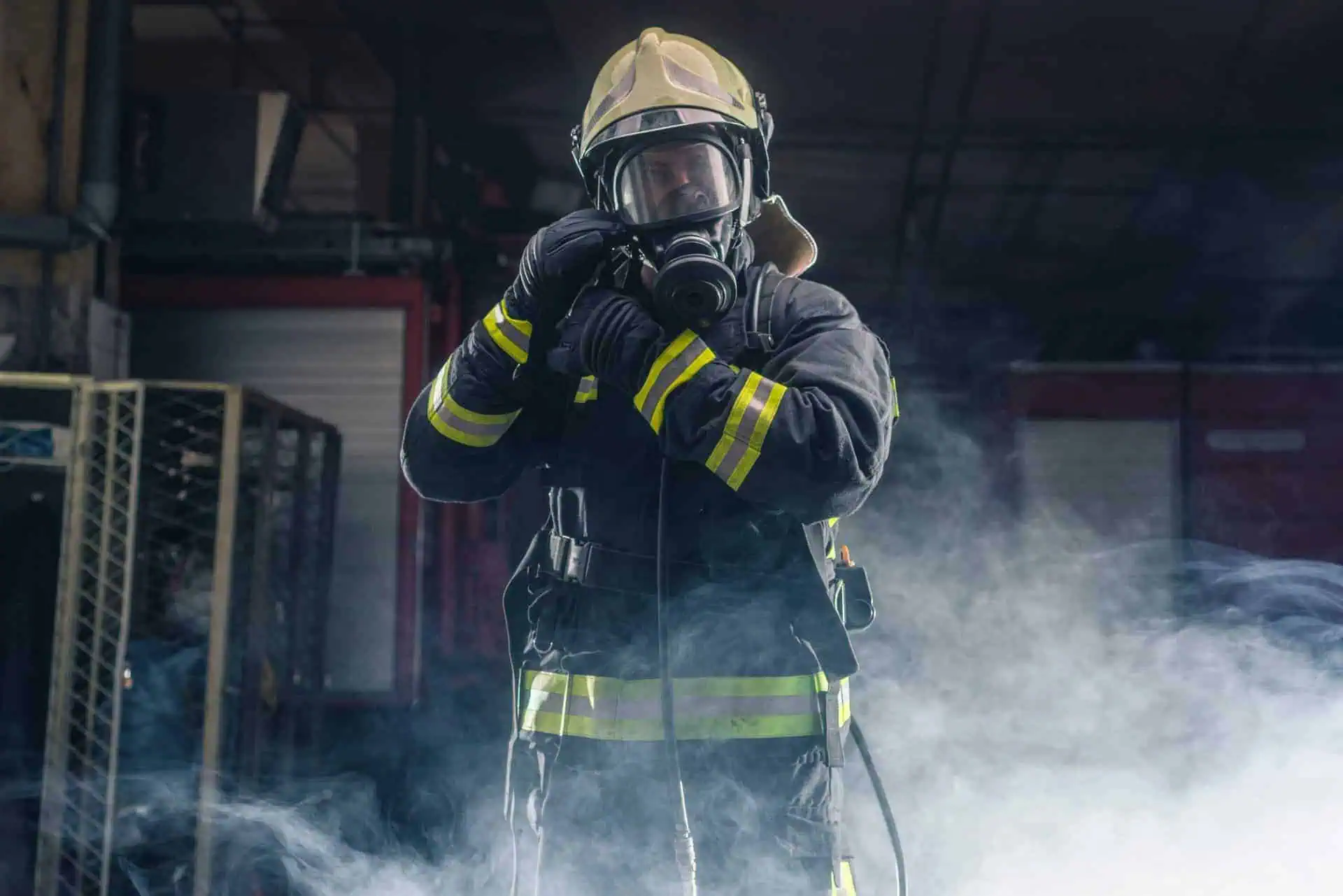PFAS in Firefighting Gear: What You Need to Know
- Last Updated: July 14th, 2025

Attorney Jessica Paluch-Hoerman, founder of TruLaw, has over 28 years of experience as a personal injury and mass tort attorney, and previously worked as an international tax attorney at Deloitte. Jessie collaborates with attorneys nationwide — enabling her to share reliable, up-to-date legal information with our readers.
Legally Reviewed
This article has been written and reviewed for legal accuracy and clarity by the team of writers and legal experts at TruLaw and is as accurate as possible. This content should not be taken as legal advice from an attorney. If you would like to learn more about our owner and experienced injury lawyer, Jessie Paluch, you can do so here.
Fact-Checked
TruLaw does everything possible to make sure the information in this article is up to date and accurate. If you need specific legal advice about your case, contact us by using the chat on the bottom of this page. This article should not be taken as advice from an attorney.
Key takeaways:
- Firefighters face significant health risks due to PFAS exposure from their protective gear, including increased risk of various cancers, suppressed immune function, hormone disruption, and elevated cholesterol.
- Efforts to remove PFAS from firefighting gear have been unsuccessful, highlighting the need for continued advocacy, collaboration with regulatory bodies, and the development of safer alternatives that meet necessary safety standards.
- Firefighters can take preventative measures to reduce their exposure to PFAS, such as only wearing turnout gear when essential, treating PPE with respect, keeping gear separate from living areas, and washing gear before wearing it.
Overview of PFAS in Firefighting Gear
On this page, we’ll discuss the presence of PFAS in firefighting gear, health risks associated with PFAS in firefighting gear for firefighters, steps being taken to address PFAS-contaminated firefighting gear and much more.
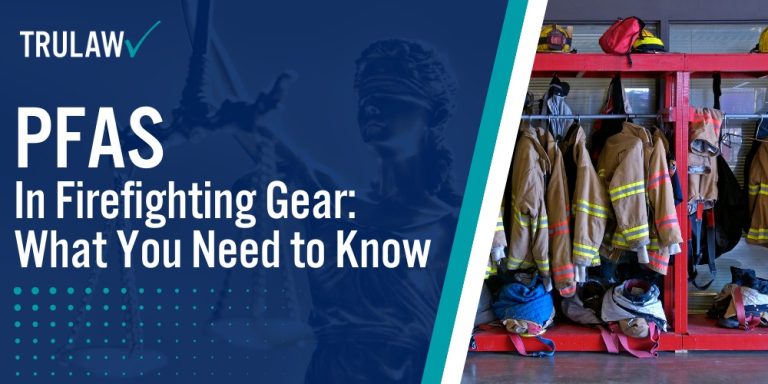
Intro to PFAS in Firefighting Gear
The key concerns surrounding PFAS in firefighting gear include, but are not limited to:
- Presence of PFAS: Many firefighting gear and equipment, such as turnout gear and firefighting foam, have been found to contain PFAS chemicals.
- Health Risks: Exposure to PFAS has been linked to various health issues, including certain cancers, immune system dysfunction, and endocrine disruption.
- Occupational Exposure: Firefighters face a higher risk of PFAS exposure due to frequent contact with PFAS-containing gear and equipment.
- Contamination and Spread: PFAS can contaminate firefighters’ skin and clothing, potentially spreading to their homes and families.
If you or a loved one has been exposed to PFAS through firefighting gear and has developed health issues, you may be eligible for compensation.
Contact TruLaw today using the chat feature on this page for a free case evaluation to determine if you qualify to file a PFAS firefighting gear lawsuit.
Table of Contents
Investigating the Health Risks of PFAS Exposure
PFAS, or per and polyfluoroalkyl substances, are a group of man-made chemicals found in various firefighter gear.
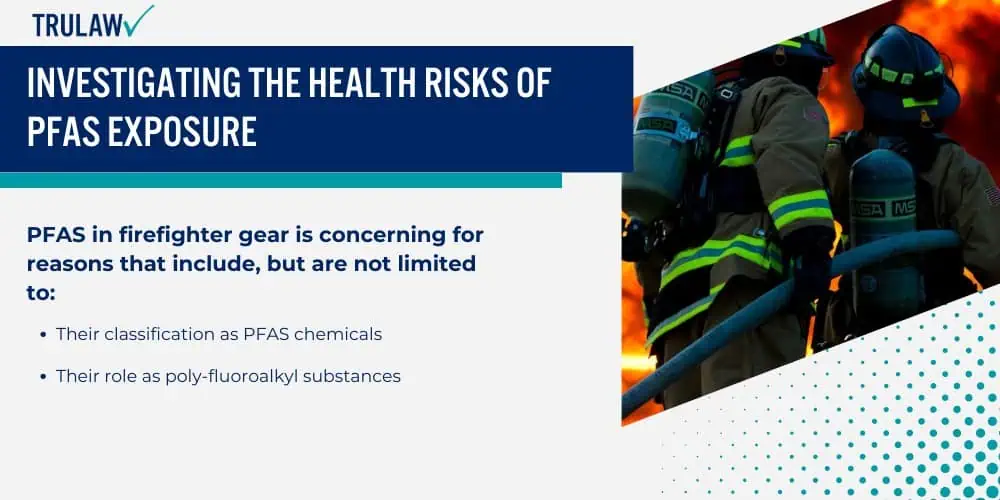
These chemicals are known for repelling water and resisting stains, making them a common component in protective clothing.
However, their persistence in the environment and human body raises serious health concerns.
What is PFAS? Per and Polyfluoroalkyl Substances Explained
PFAS are a large family of synthetic chemicals used in many industrial and consumer products, including firefighter gear.
These substances provide the necessary water repellency and durability required for effective firefighting.
PFAS are highly resistant to breaking down despite their functional benefits, leading to their nickname, forever chemicals.
PFAS in firefighter gear is concerning for reasons that include, but are not limited to:
- Their classification as PFAS chemicals
- Their role as poly-fluoroalkyl substances
The widespread use of PFAS compounds in firefighting gear highlights the need to thoroughly understand and scrutinize their long-term environmental and health impacts.
Health Risks of PFAS Exposure in Firefighter Gear
The health risks associated with PFAS exposure are significant, particularly for firefighters who experience higher levels of exposure than the general population.
Studies have linked PFAS to a range of adverse health effects, including thyroid disease, liver damage, and various forms of cancer.
Firefighters’ frequent contact with PFAS-treated gear increases their risk of developing these health issues.
Health risks from PFAS exposure in firefighter gear include, but are not limited to:
- Increased risk of thyroid disease and liver damage
- Potential links to occupational cancer
- Broader health effects observed in the general population
Given these risks, it is crucial to address the presence of PFAS in firefighting gear and explore safer alternatives to protect firefighters’ health and safety.
Historical Use and Importance of Firefighter Gear
Firefighter gear, or turnout gear, has evolved to provide maximum protection against fire, heat, and hazardous chemicals.
Including PFAS in this gear has been crucial for ensuring water repellency and durability, especially in high humidity and harsh conditions.
Despite these benefits, the long-term health implications of PFAS exposure are now raising significant concerns.
The historical importance of PFAS in firefighter gear stems from factors that include, but are not limited to:
- Their role in turnout gear
- Their use in various firefighter gear
- Enhancing protective gear and equipment
Understanding the evolution of firefighter gear highlights the balance between protective benefits and health risks.
The ongoing debate over PFAS use reflects the need for safer alternatives to protect firefighters from the immediate dangers of their work and the long-term health risks associated with PFAS exposure.
Why PFAS in Turnout Gear is a Growing Concern
The presence of PFAS in turnout gear is a growing concern due to the heightened awareness of their potential health risks.
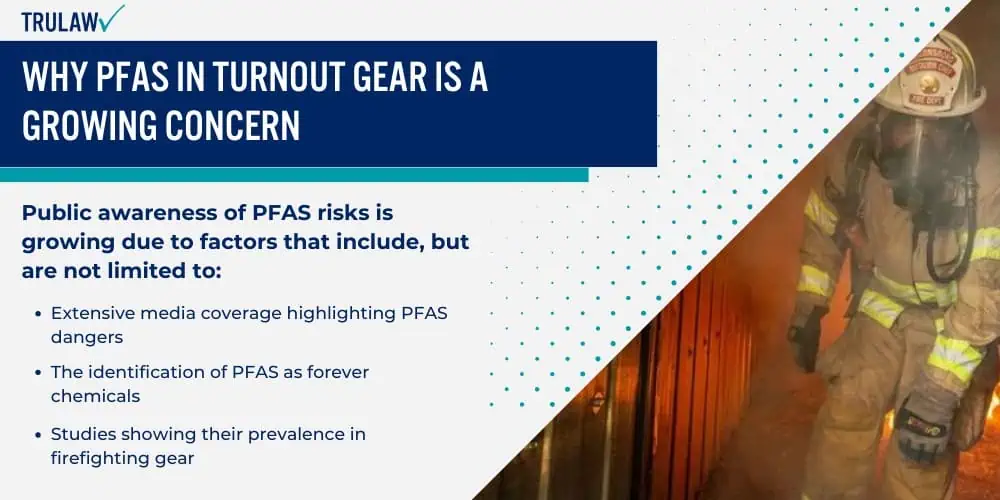
These chemicals, essential for firefighter gear’s water and stain-resistant properties, are now recognized for their persistent and bioaccumulative nature, raising alarms within the firefighting community.
Media Coverage and Public Awareness of PFAS Risks
Media coverage has significantly increased public awareness of the dangers of PFAS, also known as forever chemicals.
High-profile reports and studies have shed light on the extensive use of PFAS in firefighting gear and the associated health risks.
This increased scrutiny has led to a demand for greater transparency and accountability from manufacturers and regulatory bodies.
Public awareness of PFAS risks is growing due to factors that include, but are not limited to:
- Extensive media coverage highlighting PFAS dangers
- The identification of PFAS as forever chemicals
- Studies showing their prevalence in firefighting gear
As the public becomes more informed, there is a stronger push for safer alternatives and stricter regulations on using PFAS in protective clothing.
Firefighter-Specific Concerns with PFAS Exposure
Firefighters face unique risks due to their frequent and prolonged exposure to PFAS in their protective gear.
The firefighting community has raised concerns about the health implications of these chemicals, particularly regarding occupational cancer and other serious health conditions.
Firefighters’ bodies absorb these potentially cancer-causing chemicals through their skin, especially during high-intensity situations involving heat and sweat.
Firefighter-specific concerns with PFAS exposure include, but are not limited to:
- Increased risk of occupational cancer
- Absorption of PFAS through the skin during firefighting activities
- Persistent exposure due to the nature of their duties
The firefighting community actively advocates for research into PFAS-free alternatives and better protective measures to mitigate these risks.
This ongoing advocacy underscores the urgent need to address the presence of PFAS in firefighter gear and find safer solutions for these essential workers.
PFAS Exposure Pathways in Firefighter Protective Gear
Understanding the pathways of PFAS exposure in firefighter protective gear is crucial to mitigating risks.
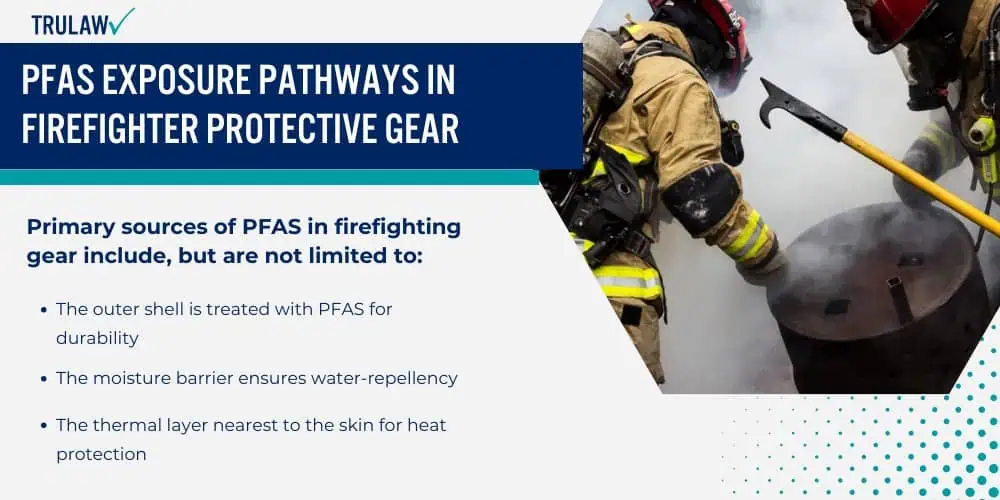
These chemicals, used extensively in firefighting gear, present multiple exposure points and significantly impact firefighters’ safety and health.
Primary Sources of PFAS in Firefighting Gear
PFAS exposure in firefighting gear occurs through various sources.
Turnout gear’s outer shell, moisture barrier, and thermal layer are commonly treated with PFAS to enhance their water—and stain resistance.
This results in firefighters coming into direct contact with these chemicals during their daily routines.
Primary sources of PFAS in firefighting gear include, but are not limited to:
- The outer shell is treated with PFAS for durability
- The moisture barrier ensures water-repellency
- The thermal layer nearest to the skin for heat protection
These layers collectively contribute to the overall effectiveness of firefighter protective clothing but also pose significant health risks due to PFAS content.
Key Studies on Measured PFAS Concentrations in Gear
Recent studies by the National Institute of Standards and Technology (NIST) have illuminated the measured PFAS concentrations in firefighter gear.
These studies indicate high levels of PFAS in various components of protective clothing, raising serious concerns about prolonged exposure and health impacts.
Key findings from studies on measured PFAS concentrations include, but are not limited to:
- High-measured PFAS concentrations in the outer shell and thermal layer
- Significant levels of PFAS in the moisture barrier
- Variations in PFAS levels depending on the age and wear of the gear
These findings underscore the urgent need for further research and the development of safer alternatives to PFAS in firefighter gear.
Current State of PFAS in Firefighting Protective Clothing
The current state of PFAS in firefighter protective clothing reveals widespread use and significant health risks.
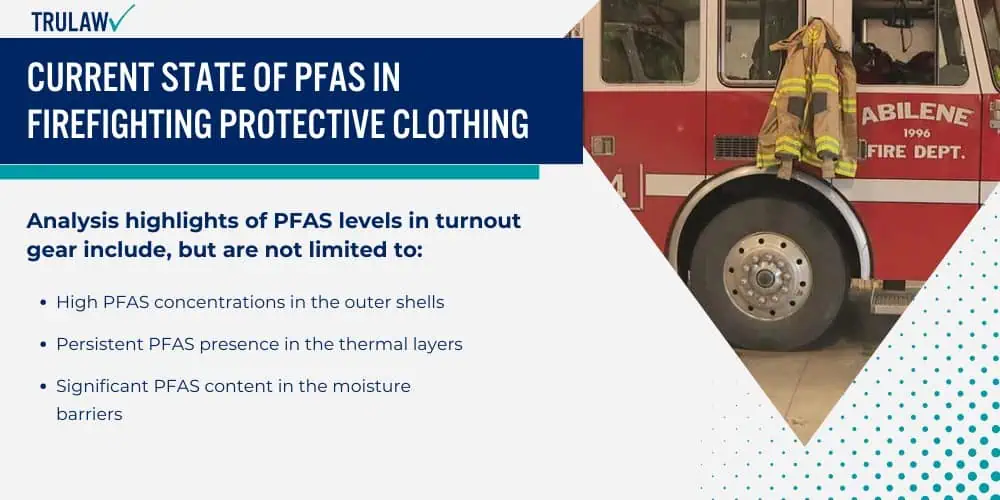
Despite growing concerns, PFAS remains integral to the design of turnout gear, posing challenges for regulatory bodies and the firefighting community.
Analysis of PFAS Levels in Firefighting Turnout Gear
Detailed analysis shows that PFAS levels in firefighter turnout gear are alarmingly high.
This gear’s outer shells, thermal layers, and moisture barriers contain substantial amounts of PFAS.
This has led to increasing scrutiny from health experts and regulatory bodies.
Analysis highlights of PFAS levels in turnout gear include, but are not limited to:
- High PFAS concentrations in the outer shells
- Persistent PFAS presence in the thermal layers
- Significant PFAS content in the moisture barriers
These findings highlight the need for stringent monitoring and regulation of PFAS in firefighter protective clothing.
NIST Studies on PFAS in Protective Equipment
The National Institute of Standards and Technology (NIST) has extensively studied PFAS in protective equipment.
These studies, led by researchers such as co-author John Kucklick, have identified significant PFAS contamination in various components of firefighter gear.
NIST studies on PFAS in protective equipment reveal findings that include, but are not limited to:
- Comprehensive analysis of PFAS levels in different gear layers
- Findings of significant PFAS contamination in commonly used protective equipment
- Recommendations for reducing PFAS exposure in firefighter gear
NIST’s research emphasizes the critical need for regulatory action and the development of safer alternatives to PFAS in protective clothing.
Health Impacts of PFAS on Firefighters
The health impacts of PFAS on firefighters are profound and concerning.
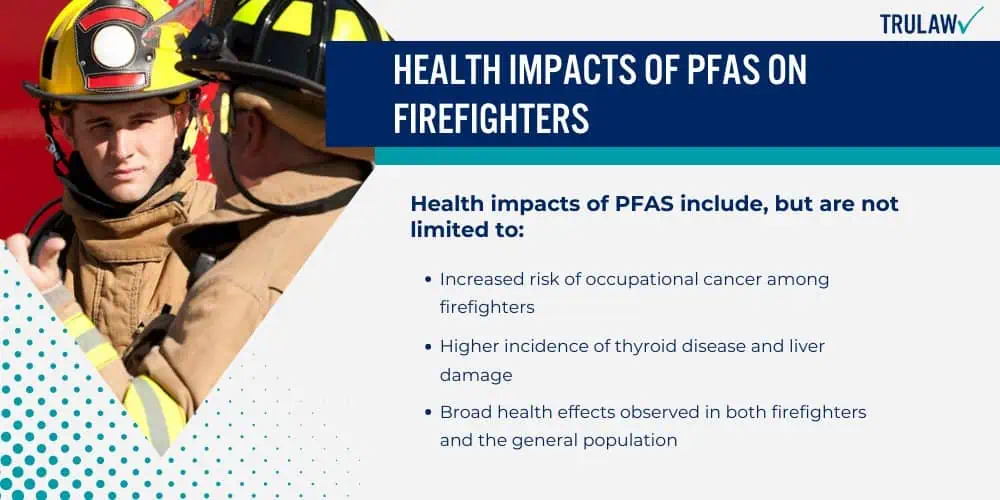
Prolonged exposure to PFAS chemicals through firefighter gear has been linked to various serious health conditions, making it a critical issue for the firefighting community.
Potentially Cancer-Causing Chemicals and Other Health Effects
PFAS are recognized as potentially cancer-causing chemicals, with numerous studies linking them to different types of cancer.
Beyond cancer, PFAS exposure is associated with other significant health issues, such as thyroid disease and liver damage.
These health risks are particularly acute for firefighters due to frequent and prolonged contact with PFAS-treated gear.
Health impacts of PFAS include, but are not limited to:
- Increased risk of occupational cancer among firefighters
- Higher incidence of thyroid disease and liver damage
- Broad health effects observed in both firefighters and the general population
Addressing these health impacts requires urgent action to reduce PFAS in firefighter gear and enhance protective measures.
Firefighters’ Increased Exposure and Occupational Cancer Risks
Firefighters experience increased PFAS exposure due to the nature of their duties and the design of their protective gear.
This exposure significantly raises their risk of developing occupational cancer and other serious health conditions.
Firefighters’ bodies absorb these chemicals through their skin, especially during high-intensity activities involving heat and sweat.
Increased PFAS exposure in firefighters leads to risks that include, but are not limited to:
- Elevated risk of occupational cancer
- Absorption of PFAS through firefighters’ skin during firefighting activities
- Persistent exposure due to the nature of their work
The firefighting community’s advocacy for safer alternatives and better protective measures is crucial to mitigating these risks and ensuring firefighters’ long-term health and safety.
Challenges in Eliminating PFAS in Firefighting Gear
Eliminating PFAS from firefighter gear poses significant challenges due to their widespread use and the essential properties they provide.
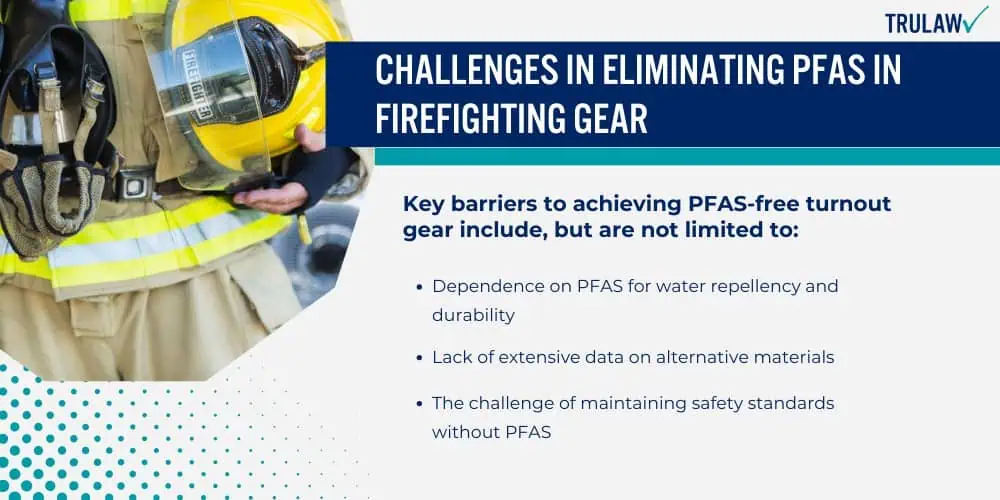
Despite the health risks, transitioning to PFAS-free turnout gear involves overcoming various barriers related to functionality, safety standards, and industry practices.
Barriers to Achieving PFAS-Free Turnout Gear
Eliminating PFAS from firefighter gear poses significant challenges due to their widespread use and the essential properties they provide.
Despite the health risks, transitioning to PFAS-free turnout gear involves overcoming various barriers related to functionality, safety standards, and industry practices.
Key barriers to achieving PFAS-free turnout gear include, but are not limited to:
- Dependence on PFAS for water repellency and durability
- Lack of extensive data on alternative materials
- The challenge of maintaining safety standards without PFAS
Addressing these barriers requires innovative research and collaboration between manufacturers, regulatory bodies, and the firefighting community to develop and implement safer alternatives.
Corporate Interests and Regulatory Hurdles
Corporate interests and regulatory hurdles significantly impact the efforts to eliminate PFAS from firefighter gear.
Manufacturers have historically relied on PFAS due to their cost-effectiveness and functional benefits.
This economic dependency creates resistance to change, compounded by regulatory frameworks that have yet to fully address the complexities of PFAS use and its health implications.
Corporate interests and regulatory challenges include, but are not limited to:
- Economic reliance on PFAS by gear manufacturers
- Inadequate regulatory measures addressing PFAS in protective gear
- Resistance to adopting alternative materials due to cost and effectiveness concerns
Overcoming these hurdles necessitates stricter regulations, increased funding for research into alternatives, and a concerted effort to prioritize firefighter health and safety over economic interests.
Exploring PFAS-Free Alternatives for Firefighting Gear
Exploring PFAS-free alternatives is essential for mitigating the health risks associated with PFAS in firefighter gear.
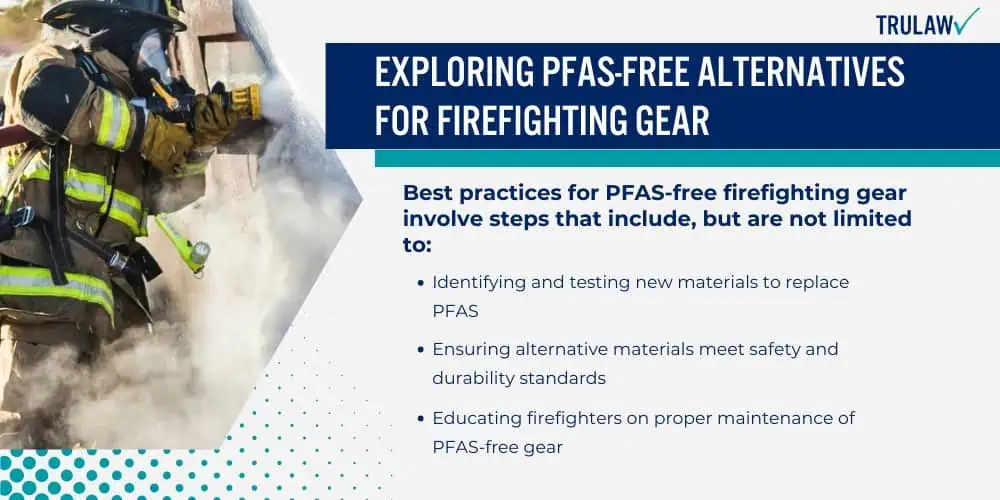
Innovations and research pave the way for safer and more sustainable options, ensuring firefighters can perform their duties without compromising their health.
Best Practices for PFAS-Free Firefighting Gear
Best practices for developing PFAS-free firefighter gear focus on using materials that provide similar protective qualities without the associated health risks.
Researchers are investigating new textiles and coatings that can replace PFAS while maintaining durability and water repellency.
Educating firefighters on handling and maintaining PFAS-free gear is paramount to ensure its effectiveness and longevity.
Best practices for PFAS-free firefighting gear involve steps that include, but are not limited to:
- Identifying and testing new materials to replace PFAS
- Ensuring alternative materials meet safety and durability standards
- Educating firefighters on proper maintenance of PFAS-free gear
Implementing these best practices requires collaboration between researchers, gear manufacturers, and the firefighting community to ensure the successful adoption of PFAS-free alternatives.
Innovations and Research in PFAS-Free Protective Clothing
The urgent need for safer alternatives drives innovations in PFAS-free protective clothing.
Research is focused on developing new coatings and fabrics that offer the same protective properties without the harmful effects of PFAS.
Organizations like the National Institute of Standards and Technology (NIST) are at the forefront of this research, providing valuable insights and recommendations for safer gear.
Innovations and research in PFAS-free protective clothing include efforts that include, but are not limited to:
- Developing new water-repellent coatings without PFAS
- Testing the effectiveness and safety of alternative materials
- Conducting extensive research to ensure long-term safety and functionality
The progress in this field is promising, highlighting the potential for widespread adoption of PFAS-free alternatives in firefighter protective clothing.
Strategies to Reduce PFAS in Firefighting Gear
Mitigation strategies for PFAS exposure in firefighter gear are crucial to protect the health of firefighters.
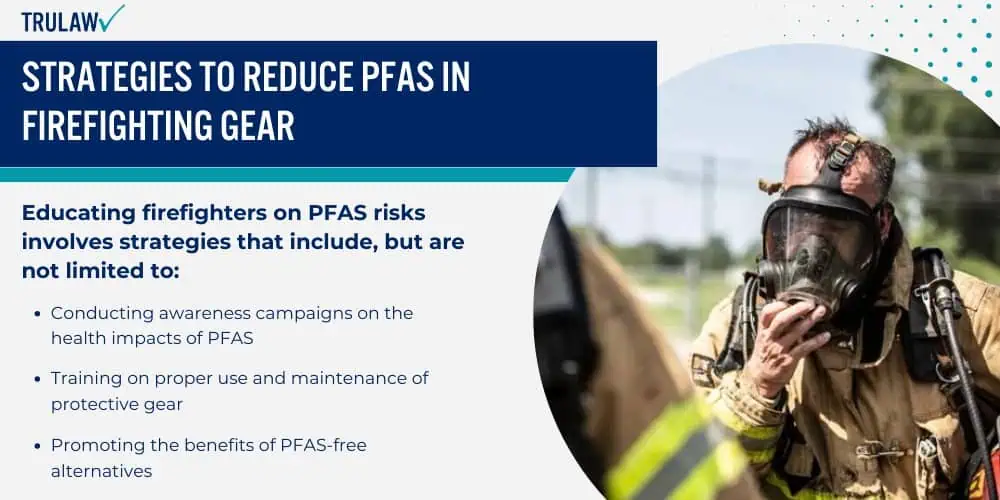
These strategies include educating firefighters on the risks, implementing best practices for handling and cleaning gear, and advocating for safer alternatives.
Educating Firefighters on PFAS Risks and Safety Measures
Educating firefighters on the risks associated with PFAS and the importance of safety measures is vital.
Awareness campaigns and training sessions can help firefighters understand the health implications of PFAS exposure and adopt practices that minimize their risk.
This includes proper use and maintenance of gear and recognizing the importance of transitioning to PFAS-free alternatives.
Educating firefighters on PFAS risks involves strategies that include, but are not limited to:
- Conducting awareness campaigns on the health impacts of PFAS
- Training on proper use and maintenance of protective gear
- Promoting the benefits of PFAS-free alternatives
Effective education and training can significantly reduce PFAS exposure and enhance firefighters’ overall safety and health.
Handling and Cleaning Gear to Reduce PFAS in Firefighting Gear
Properly handling and cleaning of firefighter gear are essential to reduce PFAS exposure.
Firefighters should be trained on best practices for decontaminating their gear to minimize the transfer of PFAS to their skin and environment.
This includes regular cleaning protocols and specialized cleaning agents designed to remove PFAS residues effectively.
Reducing PFAS exposure through handling and cleaning involves practices that include, but are not limited to:
- Implementing regular cleaning protocols for firefighter gear
- Using specialized cleaning agents to remove PFAS residues
- Training firefighters on decontamination procedures
By adopting these practices, firefighters can significantly lower their risk of PFAS exposure and maintain a safer working environment.
Future Directions and Initiatives on Removing PFAS in Firefighting Gear
Future directions and initiatives for PFAS focus on research, advocacy, and implementing safer alternatives in firefighter gear.
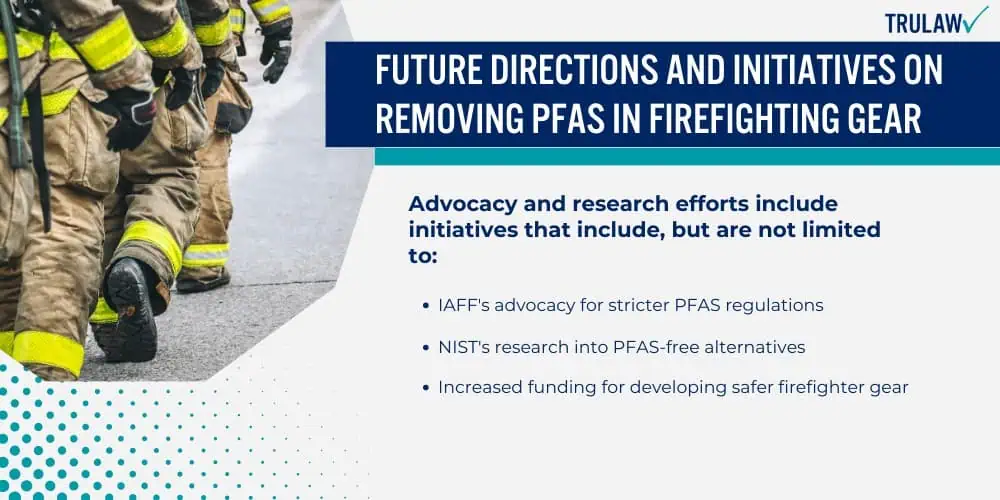
These efforts aim to reduce the health risks associated with PFAS exposure and ensure the safety and well-being of firefighters.
Advocacy and Research on PFAS-Free Gear
Advocacy and research play a crucial role in promoting PFAS-free gear.
Organizations like the International Association of Fire Fighters (IAFF) advocate for stricter regulations and increased funding for research into safer alternatives.
Research initiatives by institutions like the National Institute of Standards and Technology (NIST) are critical in developing and validating new materials that can replace PFAS in firefighter protective clothing.
Advocacy and research efforts include initiatives that include, but are not limited to:
- IAFF’s advocacy for stricter PFAS regulations
- NIST’s research into PFAS-free alternatives
- Increased funding for developing safer firefighter gear
These initiatives are essential for transitioning to PFAS-free gear and ensuring firefighters’ long-term health and safety.
Firefighter Turnout Gear Lawsuit Frequently Asked Questions
-
While efforts are underway to develop PFAS-free gear, no viable alternative meets the necessary safety standards set by the National Fire Protection Association.
-
The amount of PFAS present varies widely across different types of personal protective equipment (PPE), also called turnout gear.
Studies by the National Institute of Standards and Environmental Protection Agency have found the highest PFAS concentrations in the gear’s moisture barrier layer.
-
Yes, research indicates that older and more heavily used gear tends to have more PFAS, as these chemicals accumulate through repeated exposure and wear and tear.
This highlights the importance of regularly replacing and updating firefighting gear to minimize firefighter exposure to PFAS.
-
Firefighters face an elevated risk of certain cancers, including testicular cancer, prostate cancer, and mesothelioma, which have been linked to PFAS exposure.
Other potential health effects include immune system suppression, thyroid dysfunction, and increased cholesterol levels.
-
The National Fire Protection Association is working with manufacturers, researchers, and the fire service to develop and implement PFAS-free alternatives for firefighting gear.
Advocacy groups are also pushing for stricter regulations on PFAS use and increased transparency from manufacturers regarding the presence of these chemicals in their products.

Managing Attorney & Owner
With over 25 years of legal experience, Jessica Paluch-Hoerman is an Illinois lawyer, a CPA, and a mother of three. She spent the first decade of her career working as an international tax attorney at Deloitte.
In 2009, Jessie co-founded her own law firm with her husband – which has scaled to over 30 employees since its conception.
In 2016, Jessie founded TruLaw, which allows her to collaborate with attorneys and legal experts across the United States on a daily basis. This hypervaluable network of experts is what enables her to share the most reliable, accurate, and up-to-date legal information with our readers!
Additional Firefighter Turnout Gear Lawsuit resources on our website:
Here, at TruLaw, we’re committed to helping victims get the justice they deserve.
Alongside our partner law firms, we have successfully collected over $3 Billion in verdicts and settlements on behalf of injured individuals.
Would you like our help?
At TruLaw, we fiercely combat corporations that endanger individuals’ well-being. If you’ve suffered injuries and believe these well-funded entities should be held accountable, we’re here for you.
With TruLaw, you gain access to successful and seasoned lawyers who maximize your chances of success. Our lawyers invest in you—they do not receive a dime until your lawsuit reaches a successful resolution!
AFFF Lawsuit claims are being filed against manufacturers of aqueous film-forming foam (AFFF), commonly used in firefighting.
Claims allege that companies such as 3M, DuPont, and Tyco Fire Products failed to adequately warn users about the potential dangers of AFFF exposure — including increased risks of various cancers and diseases.
Depo Provera Lawsuit claims are being filed by individuals who allege they developed meningioma (a type of brain tumor) after receiving Depo-Provera birth control injections.
A 2024 study found that women using Depo-Provera for at least 1 year are five times more likely to develop meningioma brain tumors compared to those not using the drug.
Suboxone Tooth Decay Lawsuit claims are being filed against Indivior, the manufacturer of Suboxone, a medication used to treat opioid addiction.
Claims allege that Indivior failed to adequately warn users about the potential dangers of severe tooth decay and dental injuries associated with Suboxone’s sublingual film version.
Social Media Harm Lawsuits are being filed against social media companies for allegedly causing mental health issues in children and teens.
Claims allege that companies like Meta, Google, ByteDance, and Snap designed addictive platforms that led to anxiety, depression, and other mental health issues without adequately warning users or parents.
Transvaginal Mesh Lawsuits are being filed against manufacturers of transvaginal mesh products used to treat pelvic organ prolapse (POP) and stress urinary incontinence (SUI).
Claims allege that companies like Ethicon, C.R. Bard, and Boston Scientific failed to adequately warn about potential dangers — including erosion, pain, and infection.
Bair Hugger Warming Blanket Lawsuits involve claims against 3M — alleging their surgical warming blankets caused severe infections and complications (particularly in hip and knee replacement surgeries).
Plaintiffs claim 3M failed to warn about potential risks — despite knowing about increased risk of deep joint infections since 2011.
Baby Formula NEC Lawsuit claims are being filed against manufacturers of cow’s milk-based baby formula products.
Claims allege that companies like Abbott Laboratories (Similac) and Mead Johnson & Company (Enfamil) failed to warn about the increased risk of necrotizing enterocolitis (NEC) in premature infants.
Here, at TruLaw, we’re committed to helping victims get the justice they deserve.
Alongside our partner law firms, we have successfully collected over $3 Billion in verdicts and settlements on behalf of injured individuals.
Would you like our help?
